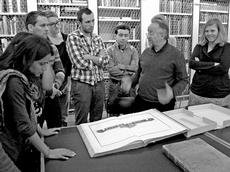Students build ‘Tower of Babylon’
As part of a global competition, students are building an object for their campus using local materials. A team from ETH Zurich that is also taking part is looking to tell a story about the conservation of value using university waste. That’s the idea; now all that remains is to build it.

Few architects get the opportunity to pit their creativity against teams from all over the world while they’re still at university. It’s mostly just well-known architecture firms that dispatch their ideas around the globe in international competitions. Not so with the ‘Tower of Babylon’ competition, however, which was launched by the Global Alliance of Technical Universities (see box): this summer five teams from architecture universities in Singapore, China, the USA, India and Switzerland are competing against each other with both their designs and their own constructions.
Interdisciplinary teams of students are to design and construct an object using local materials that addresses sustainability in a global context and at the same time is a symbol for the country, region and local university campus. Each team has a maximum four months and 1,000 US dollars for the project. An international jury of artists, architects and scientists will pick the strongest structure based on criteria such as creativity, quality, relevance to the topic ‘limits – large problems of our society’ and presentation. Afterwards, the object can either remain as a permanent feature on campus or will have to be dismantled again the same week it was erected.
ETH-Zurich team in Einsiedeln on philosophy-finding mission
The Assistant chair of Building Structure at the Department of Architecture, ETH Zurich advertised the competition as an elective for its students. Twelve applicants were chosen, including nine architects, two environmental scientists and a construction engineer (the Chair setting great store by an interdisciplinary and international structure). The twelve students met for the first time in mid-March for a brainstorming session. And so the first phase of the competition had begun: the search for a project philosophy.
Werner Oechslin invited the team to visit his library in Einsiedeln for inspiration. The professor emeritus of art history and polymath introduced the students to the story of man’s quest for divine perfection. He described the title ‘Tower of Babylon’ as a symbol of excessive human ambition and a simplified metaphor of an age-old human urge. ‘The talk inspired us to think seriously about the story we wanted to tell for the first time, instead of getting straight down to the design and materials,’ says Pascal Hendrickx, the student team’s spokesman. After some more brainstorming, the team finally settled on sine oscillation: ‘A kind of cycle with a temporal dimension and a symbol for the ebb and flow of success and failure,’ explains Hendrickx. ‘Neither the last nor the first thing ever ends up at the starting point.’ They had found their philosophy. In the second project phase, the design, the team members focused on the question as to how this could be conveyed in a construction. They decided to make their object out of waste products from ETH Zurich, noticing the towers of cardboard and paper that pile up at the Department of Architecture every day. They are counting on their fellow students to help collect the raw material. ‘The construction should be based on the contribution of a community,’ says Hendrickx.
The students are currently busy perfecting the design of their ‘Tower of Babylon’ (although the competition doesn’t explicitly state that it has to be a tower) and looking for a suitable place to build it. They have already decided that the construction should be dismantled into smaller sections afterwards; units that retain their function, and therefore their value, over a long period. ‘This is where the sine curve comes into play again: we build something big – that’s the peak. Then comes the trough: we dismantle it but don’t end up back where we started, with the waste product.’
The attraction of the concrete
For Hendrickx, the motivation to get involved in the elaborate project wasn’t the two credit points for the elective or the prize, which is mainly publicity for the winning team; he did it to build something effectively, ‘pick up the hammer and nails’, and not just produce plans and renderings for once. What’s more, working in a twelve-man international team is a challenge and experience that could come in extremely handy out in the real world later on. And despite the team’s different cultural, historical and subject backgrounds, there hasn’t been a Babylonian confusion of tongues, Hendrickx affirms. The collaboration has been an enriching experience for everyone and they are confident their competition entry will, quite literally, be towering above the ETH-Zurich campus come the second week of June.
‘Tower of Babylon’ initiated by IIA
The competition was initiated and is coordinated by ETH Zurich’s International Institutional Affairs (IIA). It takes place within the Global Alliance of Technological Universities, an association of seven leading international technical universities, of which ETH Zurich is also a member.







READER COMMENTS